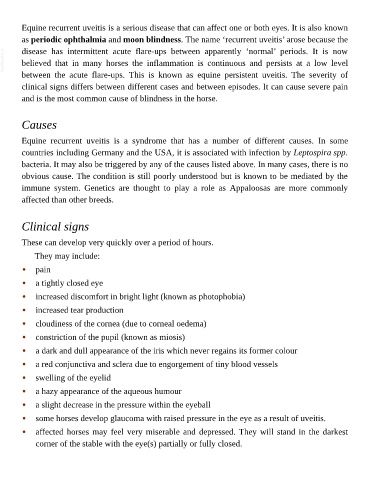Page 993 - The Veterinary Care of the Horse
P. 993
Equine recurrent uveitis is a serious disease that can affect one or both eyes. It is also known
as periodic ophthalmia and moon blindness. The name ‘recurrent uveitis’ arose because the
VetBooks.ir disease has intermittent acute flare-ups between apparently ‘normal’ periods. It is now
believed that in many horses the inflammation is continuous and persists at a low level
between the acute flare-ups. This is known as equine persistent uveitis. The severity of
clinical signs differs between different cases and between episodes. It can cause severe pain
and is the most common cause of blindness in the horse.
Causes
Equine recurrent uveitis is a syndrome that has a number of different causes. In some
countries including Germany and the USA, it is associated with infection by Leptospira spp.
bacteria. It may also be triggered by any of the causes listed above. In many cases, there is no
obvious cause. The condition is still poorly understood but is known to be mediated by the
immune system. Genetics are thought to play a role as Appaloosas are more commonly
affected than other breeds.
Clinical signs
These can develop very quickly over a period of hours.
They may include:
• pain
• a tightly closed eye
• increased discomfort in bright light (known as photophobia)
• increased tear production
• cloudiness of the cornea (due to corneal oedema)
• constriction of the pupil (known as miosis)
• a dark and dull appearance of the iris which never regains its former colour
• a red conjunctiva and sclera due to engorgement of tiny blood vessels
• swelling of the eyelid
• a hazy appearance of the aqueous humour
• a slight decrease in the pressure within the eyeball
• some horses develop glaucoma with raised pressure in the eye as a result of uveitis.
• affected horses may feel very miserable and depressed. They will stand in the darkest
corner of the stable with the eye(s) partially or fully closed.

